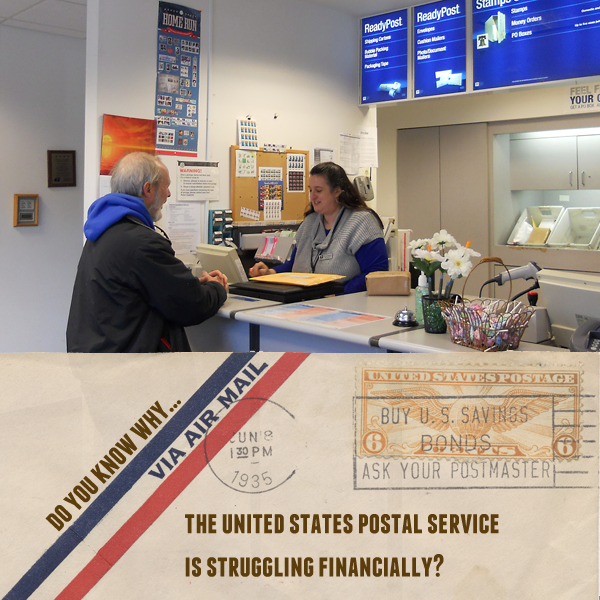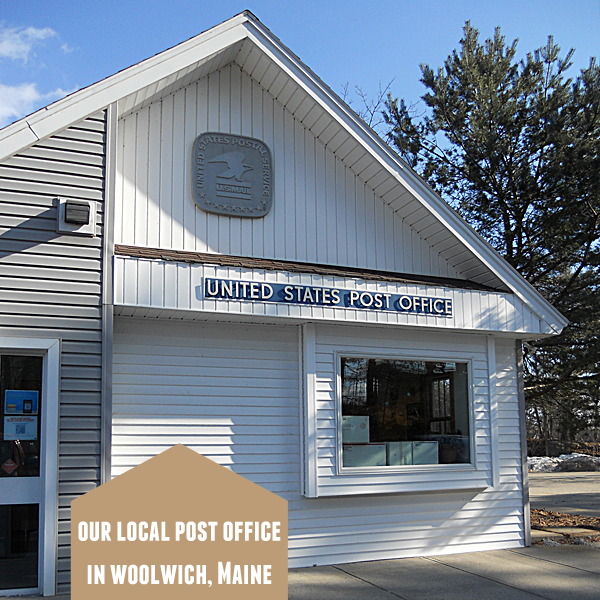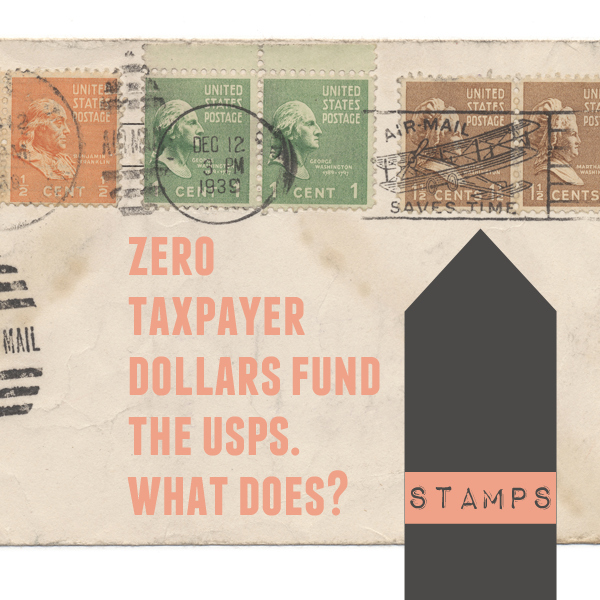
Meet Ruth. She’s the postmaster at our local post office in Woolwich, Maine where we drop off our product to be shipped out to our customers in the US and abroad. You don’t have to be on a first name basis with your post office to use this service or appreciate its value. As a small business owner, the United States Postal Service (USPS) plays a major role in my day-to-day operations. We ship 70% of the items we sell in our Etsy shop using Priority Mail and the other 30% using UPS for our larger boxes. So, when I heard the news about the reason behind the financial crisis that faces the USPS and the end of Saturday mail delivery—my ears perked up and I’m pretty sure yours will too. Instead of giving solutions to this situation that affects so many of our businesses I did some research and digging so I could share the facts with you all for my first OMHG contribution. Together we can explore the problem and hopefully come up with some creative ideas. So get out your magnifying glass and notebook, let’s get investigating!
PAEA & THE USPS
On December 20, 2006 George W. Bush signed the Postal Accountability and Enhancement Act (PAEA), the first broad reform of the USPS since 1970. The PAEA made over 150 changes to postal law, but I’d like to focus on 2 major provisions—the restriction of nonpostal activities and the prepayment of retiree health care costs. You may or may not have heard about this 2006 legislation as the current news about the USPS revolves around their state of financial distress and talk of ways to stem losses, like ending Saturday mail delivery. What’s interesting is that this state can be traced back to the PAEA and the provision that requires the USPS to prepay 75 years of retirement benefits in a short 10 year span. That amounts to a whopping 5.5 billion dollar expense each year! Senator Bernie Sanders pointed out in an interview on The Ed Show, “There is no entity in America—not any agency of government, not any private corporation—that has anything near this kind of onerous requirement in terms of funding future retiree benefits. Nobody.” It’s totally unprecedented and it is like a parasite that is choking the system from within.
On top of this huge financial burden, the USPS is restricted on the other end from exploring new services that are outside of the PAEA definition of the term “Postal Service”. Kevin Kosar of the Congressional Research Service notes in his Dec. 2009 report, “Section 101 of the law defines ‘postal service’ to mean ‘the delivery of letters, printed matter, or mailable packages, including acceptance, collection, sorting, transportation, or other functions ancillary thereto.’ This provision is significant because previously the law did not define ‘postal service,’ an omission, critics have contended, that permitted the USPS to undertake nonpostal activities (e.g., the sale of prepaid phone cards) to the detriment of private-sector firms.” With the PAEA required annual expense of 5.5 billion a year to prefund future retiree health benefits and a block on growth outside of “nonpostal activities”, the USPS is essentially trapped. The only service mentioned in the United States Constitution, is not being ‘enhanced’, but is being smothered.
IS THE INTERNET MAKING THE USPS IRRELEVANT?
Let me rewind a bit. How often do you hear that the USPS has been losing money because it simply cannot compete in this digital age; that it’s becoming increasingly irrelevant? Have we not accepted on a certain level that this is true; that there is a connection between declining mail volume and the electronic era? This is why I found the following testimony by Kevin Kosar to the House Oversight Committee in 2010 to be so interesting. In this clip Mr. Kosar responds to a USPS report and his research uncovered some fascinating facts. I’ve transcribed a part of his testimony that begins at 20:15
“…the report’s 2020 projection heavily rests on the assumption that mail volume will fall steadily, this assumption appears to be based upon a single study by the Boston Consulting Group, which contends that the rise of the Internet has created a quote ‘fundamental and permanent change in mail use by households and businesses”. This forecast about the future demand for hard copy mail is striking. As the figures on page 12 of my written testimony indicate, since 1930, mail volumes have grown steadily. The consultants forecast declares that this long lasting trend has ended—permanently. Now, this projected 2020 scenario may be questioned on at least 2 grounds. First, the use of email and the Internet has been growing since the mid 1990’s. Yet, between FY1995 and FY 2006, mail volume went up—significantly. So, thus far it does not appear that when the demand for electronic communications goes up, the demand for all forms of hard copy mail must go down. Second and relatedly, the recent drop in mail volume began about 4 months after the US economy had officially entered a deep recession. So, it seems at least plausible that the economic downturn, not the Internet, was the more significant factor in instigating the recent sudden mail volume declines of the past 2 years. And if that is the case, then the Postal Service’s mail volumes and hence, its revenues might rise again as the economy improves. So, Congress may wish to study further the recent decline in mail volume to better determine whether this is a temporary change or as the Postal Service contends, a permanent one.”
I began to wonder if this idea of a mail volume decline crisis due to the Internet was not true—but one that has taken root because we’ve agreed to the story. It’s easy to understand as we all have the direct experience of moving away from mailing things as we shop more online. Yet I may be able to pay my utilities online, but I’m pretty sure I can’t ship that mail holder to San Francisco in an instant by pressing a send key! Some things will become electronic but others simply can’t. Also the Internet has opened up a huge market for online shopping and all those tangible items purchased online have to be shipped. So is it reasonable to think that a whole system will collapse, forever, because we now pay our credit card bills online? And all because of findings presented in one study? The USPS is not obsolete and is extremely relevant to all of us. The private sector cannot deliver the same level of service that the USPS does—UPS and FedEx won’t deliver to rural areas, they actually contract with the USPS for those deliveries. Live in an area where you have a P.O. Box? Sorry, UPS and FedEx won’t deliver to those either. When you think about it, the reach of service that the USPS is able to provide is astonishing—every single person in the US is touched by this service when mail gets delivered to your doorstep.
SO WHAT IS THE SOLUTION TO THE USPS CRISIS?
As a small business owner, I know that the USPS is not irrelevant. I also know now that it is facing a financial crisis because of this 2006 PAEA law and not because “it keeps losing money in this digital age”. The USPS requires ZERO taxpayer dollars to operate—it is a self-funded agency and supports itself through the sale of postage stamps. It’s not an ogre of an agency that needs taxpayer money to survive but a service that is for the benefit of all. Politicians on both sides of the aisle are working on postal reform, but what’s the solution here to this enormous legislative mess? Is it to cut Saturday mail delivery, is it to pass legislation to reduce the prepayment amount (which was done in FY2009), delay the due date of this prepayment (which was done in FY2011), is it to repeal the 2006 PAEA law (some have started a petition for this), do we bombard our state representatives and ask them to work for postal reform? In the end, is the answer to be found in the hands of those in the government OR will it come about as a result of a grassroots movement to raise awareness and find a creative solution? Will ending Saturday mail delivery be enough to help the USPS recover financially? I don’t have an answer, but I trust in the collective ability to problem solve and it’s my hope that together we’ll come up with something powerful! Initially, I thought I would write this post with an action plan in mind, but then I realized that my job was to bring awareness to the topic through sharing what I’ve learned. I have watched numerous videos and read various articles, but have mainly quoted Kevin Kosar’s fact focused research. Since this is an issue that impacts so many of us I wanted to gather up my facts and present them to the OMHG community to see what you think of the situation.
As an American small business owner, I cannot imagine a world without the United States Postal Service – can you? In the comments below, share with us where you live, your business and how the USPS relates to you. I invite you to leave your thoughts, ideas, experiences and possible solutions to see what sort of creative inspiration will move through us all! I believe together as one voice, change is always possible.
Sources
Vintage Envelope images via Fuzzimo.com
Kosar, Kevin. “The Postal Accountability and Enhancement Act: An Overview for Congress”. Congressional Research Service. December 14, 2009.
Kosar, Kevin. “The Postal Accountability and Enhancement Act: An Overview for Congress”. Congressional Research Service. December 14, 2009.
http://www.youtube.com/watch?v=aiwYQts9_qA Senator Sanders. “Saving the Postal Service”. YouTube. Web. 5 April, 2012
Kosar, Kevin. “The Postal Accountability and Enhancement Act: An Overview for Congress”. Congressional Research Service. December 14, 2009.




